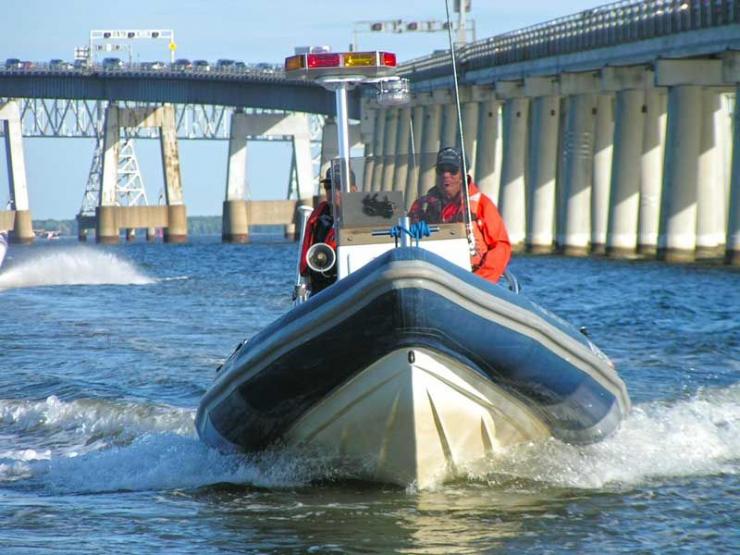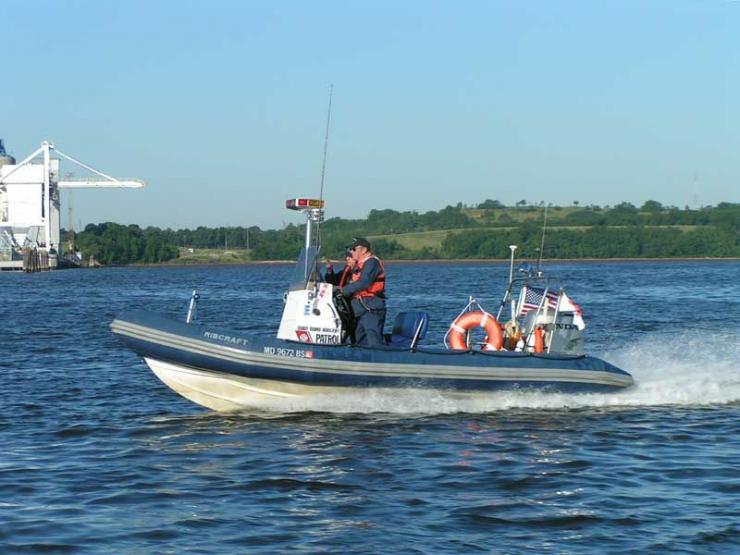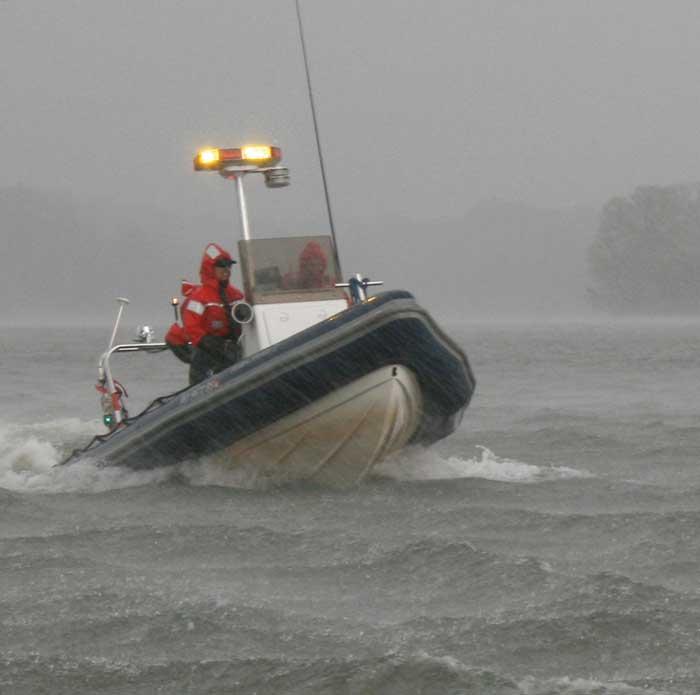Call him Mr. Rescue. It started in the early 1980s, when Jim Welday’s 21-foot runabout got entangled in crab lines. The Coast Guard dispatched rescue boats only in cases of emergency, as towboat services were rare, and routine radio calls often went unanswered. Jim and his wife, Mary, finally attracted attention by waving a spare diaper they’d brought for their then-baby daughter, Michelle.

“Four boats came over to help,” he recalls.
After a second such stranding several months later, Welday decided that recreational boaters needed a helping hand and that he could help provide it. He began monitoring channel 16 and responding whenever he heard a trouble call, even towing the disabled vessel back to a marina if necessary. A former Army helicopter pilot, he viewed it as a public service.
“It’s a kick for me to do this,” he told friends at the time.
In 1992, Welday formalized his rescue efforts, joining the U.S. Coast Guard Auxiliary, whose members patrol Chesapeake Bay tributaries on weekends and holidays. Within a few years, he became a patrol boat commander and eventually qualified as a radio watchstander at Coast Guard Station Annapolis, near Thomas Point, to help handle emergency calls.
Over the past 18 years—as far back as current records go—Welday has put in 2800 hours on Auxiliary patrols, assisted 88 recreational boaters, and taken part in 21 search-and-rescue cases. He has become one of a handful of Auxiliarists whom the station dispatches on more serious search-and-rescue calls. He’s also racked up 3400 hours as a radio watchstander.
He still gets a kick out of it. “It’s a satisfying feeling,” he says.

Welday hasn’t been a lifelong boater. Although he paddled a canoe occasionally as a high schooler, he didn’t get into water sports seriously until he’d graduated from the University of Maryland and finished a seven-year stint in the service. He and Mary began renting boats and eventually bought the 21-footer. Helping boaters who got in trouble became a family pastime.
Welday’s current boat is a blue and beige 19-foot center console, rigid-hull inflatable called Delta 4 that, not surprisingly, looks a bit like a 21-foot Coast Guard patrol boat without the insignia and bright-orange color. Besides going out on patrols (Auxiliarists use their own boats for such activities), Welday trains other Auxiliary coxswains and crewmembers.
His skills have become legendary. Putt-putting into the Sandy Point State Park basin for a training session one time, Welday spotted a recreational boat that had run aground at the side of the narrow entry channel. With a green crew, he clapped towlines on the stranded boat and towed it into the basin, hardly stopping in the process. Other boat crews just shook their heads.
Welday strictly follows Coast Guard procedures as a watchstander and as a patrol-boat coxswain, but he adds his own touch when he’s on the water. Instead of just looking for boaters in distress, he keeps a close eye on vessels that he thinks may be heading for trouble and stays in their general location so he can be there if they run aground or break down.
As is often the case with patrols, the workload is erratic; some days are chock-full of action, while others pass with hardly a ripple. On one memorable day, Welday helped right an overturned sailboat, rescued a couple from a sloop beset by sudden strong breezes, extricated a grounded runabout, and pulled five boaters off a stranded powerboat in rough seas.
Now 73, Welday continues to work full time as manager of a data-storage center in Northern Virginia, but going out on patrols and standing watches at Station Annapolis remain his hobby and his passion, and he has no plans to quit either. A patient teacher, with a calm demeanor and a dry wit, he’s quick at problem-solving and slow to lose his temper.
 Based on his experience with rescue operations, Welday lists five frequent reasons that recreational boaters get into trouble on the water:
1. They don’t check the weather
Based on his experience with rescue operations, Welday lists five frequent reasons that recreational boaters get into trouble on the water:
1. They don’t check the weather or even take time to study the forecasts properly and often get caught by heavy seas, summer storms, or squalls. Welday says, “Nothing can get you into danger more quickly.”
2. They don’t pay attention to their fuel levels and run out of gasoline or diesel fuel in the middle of the Bay. The Coast Guard recommends that you carry three times as much fuel as you’ll need for your day’s outing: one third of a tank to get there, one third to get back, and one third for reserve. “That’s just a minimum,” Welday observes.
3. They suffer more than their share of equipment failures. Some are normal breakdowns that can’t be easily prevented, but many stem from poor maintenance or inattention. “You’ve got to maintain your boat properly, or you’re asking for trouble,” Welday says.
4. They often become lost. “Too many boaters don’t even
own a nautical chart, let alone look at one, and they get out on the water and don’t know where they are,” Welday says. That invites running aground or hitting a rock. It also makes it hard to tell rescuers where you are.
5. They have poor boathandling skills. “Too many people think that just because they can drive a car, they can operate a boat, but cars and boats are very different,” Welday says. “People need to learn how to handle their boats and continually work to improve their skills.”
For more on boating safety, click to our latest Safety Series article,
Training Your Crew to Help Onboard.
About the author: Art Pine is a Coast Guard-licensed captain and a longtime powerboater and sailor on the Chesapeake Bay.
 “Four boats came over to help,” he recalls.
After a second such stranding several months later, Welday decided that recreational boaters needed a helping hand and that he could help provide it. He began monitoring channel 16 and responding whenever he heard a trouble call, even towing the disabled vessel back to a marina if necessary. A former Army helicopter pilot, he viewed it as a public service.
“It’s a kick for me to do this,” he told friends at the time.
In 1992, Welday formalized his rescue efforts, joining the U.S. Coast Guard Auxiliary, whose members patrol Chesapeake Bay tributaries on weekends and holidays. Within a few years, he became a patrol boat commander and eventually qualified as a radio watchstander at Coast Guard Station Annapolis, near Thomas Point, to help handle emergency calls.
Over the past 18 years—as far back as current records go—Welday has put in 2800 hours on Auxiliary patrols, assisted 88 recreational boaters, and taken part in 21 search-and-rescue cases. He has become one of a handful of Auxiliarists whom the station dispatches on more serious search-and-rescue calls. He’s also racked up 3400 hours as a radio watchstander.
He still gets a kick out of it. “It’s a satisfying feeling,” he says.
“Four boats came over to help,” he recalls.
After a second such stranding several months later, Welday decided that recreational boaters needed a helping hand and that he could help provide it. He began monitoring channel 16 and responding whenever he heard a trouble call, even towing the disabled vessel back to a marina if necessary. A former Army helicopter pilot, he viewed it as a public service.
“It’s a kick for me to do this,” he told friends at the time.
In 1992, Welday formalized his rescue efforts, joining the U.S. Coast Guard Auxiliary, whose members patrol Chesapeake Bay tributaries on weekends and holidays. Within a few years, he became a patrol boat commander and eventually qualified as a radio watchstander at Coast Guard Station Annapolis, near Thomas Point, to help handle emergency calls.
Over the past 18 years—as far back as current records go—Welday has put in 2800 hours on Auxiliary patrols, assisted 88 recreational boaters, and taken part in 21 search-and-rescue cases. He has become one of a handful of Auxiliarists whom the station dispatches on more serious search-and-rescue calls. He’s also racked up 3400 hours as a radio watchstander.
He still gets a kick out of it. “It’s a satisfying feeling,” he says.
 Welday hasn’t been a lifelong boater. Although he paddled a canoe occasionally as a high schooler, he didn’t get into water sports seriously until he’d graduated from the University of Maryland and finished a seven-year stint in the service. He and Mary began renting boats and eventually bought the 21-footer. Helping boaters who got in trouble became a family pastime.
Welday’s current boat is a blue and beige 19-foot center console, rigid-hull inflatable called Delta 4 that, not surprisingly, looks a bit like a 21-foot Coast Guard patrol boat without the insignia and bright-orange color. Besides going out on patrols (Auxiliarists use their own boats for such activities), Welday trains other Auxiliary coxswains and crewmembers.
His skills have become legendary. Putt-putting into the Sandy Point State Park basin for a training session one time, Welday spotted a recreational boat that had run aground at the side of the narrow entry channel. With a green crew, he clapped towlines on the stranded boat and towed it into the basin, hardly stopping in the process. Other boat crews just shook their heads.
Welday strictly follows Coast Guard procedures as a watchstander and as a patrol-boat coxswain, but he adds his own touch when he’s on the water. Instead of just looking for boaters in distress, he keeps a close eye on vessels that he thinks may be heading for trouble and stays in their general location so he can be there if they run aground or break down.
As is often the case with patrols, the workload is erratic; some days are chock-full of action, while others pass with hardly a ripple. On one memorable day, Welday helped right an overturned sailboat, rescued a couple from a sloop beset by sudden strong breezes, extricated a grounded runabout, and pulled five boaters off a stranded powerboat in rough seas.
Now 73, Welday continues to work full time as manager of a data-storage center in Northern Virginia, but going out on patrols and standing watches at Station Annapolis remain his hobby and his passion, and he has no plans to quit either. A patient teacher, with a calm demeanor and a dry wit, he’s quick at problem-solving and slow to lose his temper.
Welday hasn’t been a lifelong boater. Although he paddled a canoe occasionally as a high schooler, he didn’t get into water sports seriously until he’d graduated from the University of Maryland and finished a seven-year stint in the service. He and Mary began renting boats and eventually bought the 21-footer. Helping boaters who got in trouble became a family pastime.
Welday’s current boat is a blue and beige 19-foot center console, rigid-hull inflatable called Delta 4 that, not surprisingly, looks a bit like a 21-foot Coast Guard patrol boat without the insignia and bright-orange color. Besides going out on patrols (Auxiliarists use their own boats for such activities), Welday trains other Auxiliary coxswains and crewmembers.
His skills have become legendary. Putt-putting into the Sandy Point State Park basin for a training session one time, Welday spotted a recreational boat that had run aground at the side of the narrow entry channel. With a green crew, he clapped towlines on the stranded boat and towed it into the basin, hardly stopping in the process. Other boat crews just shook their heads.
Welday strictly follows Coast Guard procedures as a watchstander and as a patrol-boat coxswain, but he adds his own touch when he’s on the water. Instead of just looking for boaters in distress, he keeps a close eye on vessels that he thinks may be heading for trouble and stays in their general location so he can be there if they run aground or break down.
As is often the case with patrols, the workload is erratic; some days are chock-full of action, while others pass with hardly a ripple. On one memorable day, Welday helped right an overturned sailboat, rescued a couple from a sloop beset by sudden strong breezes, extricated a grounded runabout, and pulled five boaters off a stranded powerboat in rough seas.
Now 73, Welday continues to work full time as manager of a data-storage center in Northern Virginia, but going out on patrols and standing watches at Station Annapolis remain his hobby and his passion, and he has no plans to quit either. A patient teacher, with a calm demeanor and a dry wit, he’s quick at problem-solving and slow to lose his temper.
 Based on his experience with rescue operations, Welday lists five frequent reasons that recreational boaters get into trouble on the water:
1. They don’t check the weather or even take time to study the forecasts properly and often get caught by heavy seas, summer storms, or squalls. Welday says, “Nothing can get you into danger more quickly.”
2. They don’t pay attention to their fuel levels and run out of gasoline or diesel fuel in the middle of the Bay. The Coast Guard recommends that you carry three times as much fuel as you’ll need for your day’s outing: one third of a tank to get there, one third to get back, and one third for reserve. “That’s just a minimum,” Welday observes.
3. They suffer more than their share of equipment failures. Some are normal breakdowns that can’t be easily prevented, but many stem from poor maintenance or inattention. “You’ve got to maintain your boat properly, or you’re asking for trouble,” Welday says.
4. They often become lost. “Too many boaters don’t even own a nautical chart, let alone look at one, and they get out on the water and don’t know where they are,” Welday says. That invites running aground or hitting a rock. It also makes it hard to tell rescuers where you are.
5. They have poor boathandling skills. “Too many people think that just because they can drive a car, they can operate a boat, but cars and boats are very different,” Welday says. “People need to learn how to handle their boats and continually work to improve their skills.”
For more on boating safety, click to our latest Safety Series article, Training Your Crew to Help Onboard.
About the author: Art Pine is a Coast Guard-licensed captain and a longtime powerboater and sailor on the Chesapeake Bay.
Based on his experience with rescue operations, Welday lists five frequent reasons that recreational boaters get into trouble on the water:
1. They don’t check the weather or even take time to study the forecasts properly and often get caught by heavy seas, summer storms, or squalls. Welday says, “Nothing can get you into danger more quickly.”
2. They don’t pay attention to their fuel levels and run out of gasoline or diesel fuel in the middle of the Bay. The Coast Guard recommends that you carry three times as much fuel as you’ll need for your day’s outing: one third of a tank to get there, one third to get back, and one third for reserve. “That’s just a minimum,” Welday observes.
3. They suffer more than their share of equipment failures. Some are normal breakdowns that can’t be easily prevented, but many stem from poor maintenance or inattention. “You’ve got to maintain your boat properly, or you’re asking for trouble,” Welday says.
4. They often become lost. “Too many boaters don’t even own a nautical chart, let alone look at one, and they get out on the water and don’t know where they are,” Welday says. That invites running aground or hitting a rock. It also makes it hard to tell rescuers where you are.
5. They have poor boathandling skills. “Too many people think that just because they can drive a car, they can operate a boat, but cars and boats are very different,” Welday says. “People need to learn how to handle their boats and continually work to improve their skills.”
For more on boating safety, click to our latest Safety Series article, Training Your Crew to Help Onboard.
About the author: Art Pine is a Coast Guard-licensed captain and a longtime powerboater and sailor on the Chesapeake Bay.